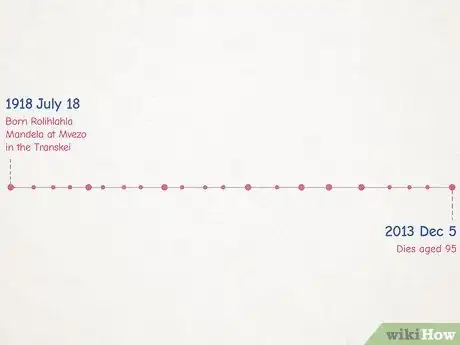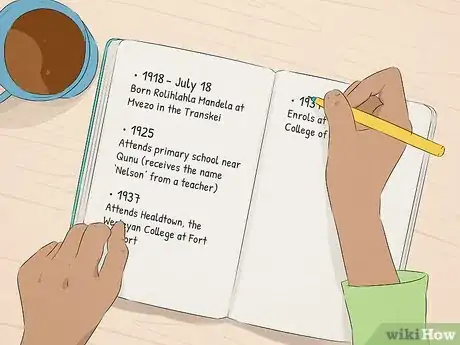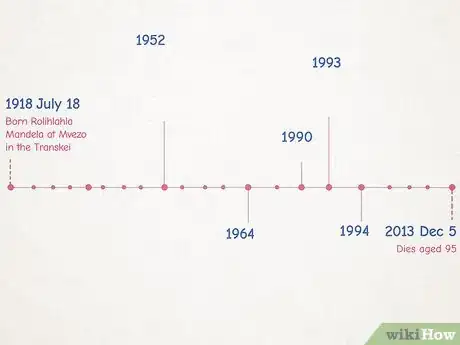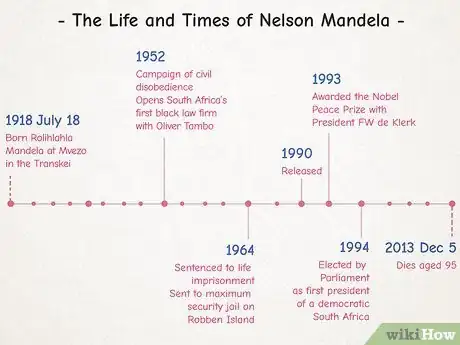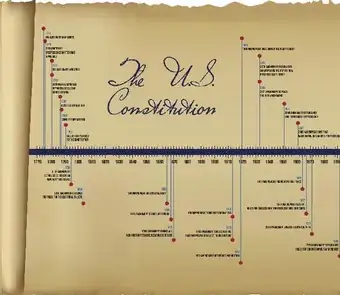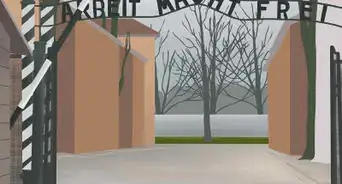This article was co-authored by Emily Listmann, MA and by wikiHow staff writer, Danielle Blinka, MA, MPA. Emily Listmann is a private tutor in San Carlos, California. She has worked as a Social Studies Teacher, Curriculum Coordinator, and an SAT Prep Teacher. She received her MA in Education from the Stanford Graduate School of Education in 2014.
This article has been viewed 808,693 times.
A timeline provides a visual representation of events that helps you better understand history, a story, a process or any other form of an event sequence. You can make a timeline to fit a variety of subjects, so they’re a common academic project. Fortunately, they are also really easy to make. To make a timeline, research your topic, create your project, and organize the events chronologically.
Steps
Researching Your Topic
-
1Gather information on your chosen or assigned topic. As you read and collect information, begin making notes about possible events to include. You will need to provide a well-rounded history of your topic, so make sure you use several sources of information.[1]
- Conduct Internet research, check out books from the library, or visit a museum or a historical site that relates in some way to your topic.
- Try to use multiple websites, books, articles, and maybe even a documentary. Aim to have at least 3 different sources.
-
2Make a list of events to include. You will want to include the important events for your topic, but also add in relevant, interesting events. While your timeline should maintain topic focus, you want it to be fun for the viewer/audience, and to show that you understand the topic.[2] Aim for no more than 20 events in a timeline, and no less than five events within your timeline.[3] Include events like:
- Personal details such as births, deaths, and other important dates should be added
- Historical events that impacted the topic of the timeline should also be incorporated into your timeline
- Important events that shaped the topic should be included as well
Advertisement -
3Use the timeline to tell a story. Though in a different format, a timeline, like a story, should flow smoothly and be engaging and interesting to read. The reader should be eager to learn about the next event, just like they would be when reading a great page-turner book!
Creating a Framework
-
1Check out example timelines. To get an idea of what timelines typically look like, do an Internet search for “timeline.” Look over several of the results so you have a good idea of how to proceed with the project.
-
2Draw your timeline. Sketch out the line using a pencil, then trace over it with a dark pen or marker. Label the timeline with the project title and the boundary years.[4]
- Use a ruler if you are making your timeline by hand.
- If you are creating a digital timeline, choose a template.
-
3Choose a start and end point. You need to set boundaries for your timeline. Your boundaries need to allow you to explore your topic, so start and end your timeline with enough space to cover all of the events.[5]
- You don’t have to start with someone’s birth or end with the person’s death. A timeline is just a series of related events, not necessarily a biography.
- Consider your topic and narrow it to select the right starting point and ending point.
-
4Decide how you will present your events. There are many ways to display your events, depending on your preferences. You will need to create an entry for each event, and they will all need to fit on the timeline.[6]
- If you’re doing this by hand, write out all the events on a separate sheet of paper before adding them to the timeline so you can figure out how much space each entry will take.
- Alternatively, you could type up each event, then print it, cut it out, and paste it to the timeline.
- If you’re using a digital method, create a slide for each event.
- Include drawings or images to add visual interest to the timeline.
-
5Select your time increments. Depending on the span of time you're working with, you might choose increments in decades, years, months, or even days. Figure out what makes sense for your subject and the number of events you're including. Make the appropriate number of evenly-spaced lines perpendicular to the main timeline between your start and end dates.[7]
- These time increments are not the years of your events. They are evenly spaced increments, such as 5 years, 10 years, or 20 years. For example, you might mark 1920, 1930, 1940, and 1950, even though your events take place in 1923, 1928, 1938, and 1943.
-
6Put the most important dates on the timeline. Go along the line and mark the spots where the events will go. Draw a line that is perpendicular to your main timeline to show the years in which the events occurred, and write down a short description of each one.[8]
- Organize the dates sequentially. The events need to be on the timeline in chronological order, not in order of importance or interest. For example, events listed throughout a year should start in January and end in December.[9]
Filling in Your Timeline
-
1Give your project a title. Choose an engaging title that tells the viewer what your timeline is about. Make sure that your title encompasses all that you’ve included in your project, rather than just the topic. For example, don’t title your project “NASA;” instead, choose a title like “NASA: The Quest for the Moon.” Example titles include:
- The Life and Times of Nelson Mandela
- Beverly Hills, 90210: A Recent History
- JD Salinger's Storied Career
- California's Ancient Redwoods
- A Day in the Life of a Praying Mantis
-
2Add details and important information about each event. For each entry, write a short explanation about what happened, including facts such as who was involved, the impact of the event, and any numbers related to the event, such as the number of people killed in a war. Add the details that help you tell the overall narrative of your timeline.[10]
-
3Write clearly and concisely. Your words need to be easy to read, so write clearly. Alternatively, type up your entries, cut them out, and glue them onto the timeline. Use as few words as possible to explain the events to avoid taking up too much space with one event.[11]
- If you’re creating a digital timeline, type up your entries.
-
4Add pictures. You can add visual interest to your timeline with some pictures to go along with the events you're including. Find images online, copy them from books, or get creative and draw them yourself.[12]
Sample Timeline
Community Q&A
-
QuestionCan the computer draw a timeline that I can print and fill out?
 Community AnswerYes. The are tons of templates online that you can use. Alternatively, you can draw your own on Word by drawing a line and each increment on that line.
Community AnswerYes. The are tons of templates online that you can use. Alternatively, you can draw your own on Word by drawing a line and each increment on that line. -
QuestionHow do I organize the info for the timeline?
 Community AnswerThe information should be organized in chronological order from the earliest event to the latest and presented in short sentences or blurbs.
Community AnswerThe information should be organized in chronological order from the earliest event to the latest and presented in short sentences or blurbs. -
QuestionIs it okay to write the same year for three different things?
 Community AnswerNo, that might confuse the person reading it. Just list the separate items under the one year, either vertically up the page or by separating each event by a semicolon.
Community AnswerNo, that might confuse the person reading it. Just list the separate items under the one year, either vertically up the page or by separating each event by a semicolon.
References
- ↑ https://www.thehomeschoolmom.com/how-to-make-a-timeline-easily/
- ↑ https://www.thehomeschoolmom.com/how-to-make-a-timeline-easily/
- ↑ https://timeline.knightlab.com/
- ↑ https://creately.com/blog/creately/how-to-draw-a-timeline/
- ↑ https://www.thehomeschoolmom.com/how-to-make-a-timeline-easily/
- ↑ https://www.thehomeschoolmom.com/how-to-make-a-timeline-easily/
- ↑ https://www.youtube.com/watch?v=pz9o15QKzMM
- ↑ http://www.datesandevents.org/creating-a-timeline.htm
- ↑ http://www.datesandevents.org/creating-a-timeline.htm
About This Article
If you need to make a timeline to help you better understand a story or a historical occurrence, make a list of all of the events you want to include in the timeline. Aim for no more than 20 events in a timeline, and look for relevant details that add interest to the story you are telling. Sketch out a line using a pencil, and label the timeline with the project title and boundary years. Add the most important dates to the timeline in sequential order, then fill in any details. For tips from our reviewer on different ways to structure your timeline, read on!





